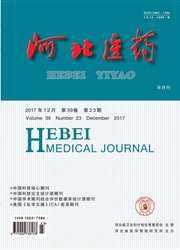

 中文摘要:
中文摘要:
目的观察丹参酮ⅡA磺酸钠联合阿托伐他汀对冠心病患者TLR4炎症信号通路及免疫相关指标的影响,以TLR4炎症信号通路为靶点探讨丹参酮ⅡA磺酸钠治疗冠心病的可能机制。方法选取2014年1月至2015年1月诊治的冠心病患者160例,随机分为对照组和观察组,每组80例。对照组在常规治疗基础上给予阿托伐他汀治疗,观察组在对照组基础上加用丹参酮ⅡA磺酸钠注射液,疗程为30d。采用Realtime-PCR测定外周血单个核细胞TLR4mRNA表达。采用酶联免疫吸附实验(ELISA)测定血清白介素-6(IL-6)、超敏C反应蛋白(hs-CRP)、肿瘤坏死因子-α(TNF-α)、基质金属白酶-9(MMP-9)及抗氧化修饰低密度脂蛋白(ox-LDL)抗体水平。流式细胞仪测定外周血淋巴细胞亚群指标(CD+3、CD+4、CD+8、CD+4/CD+8)变化。免疫比浊法测定免疫球蛋白(IgA、IgG、IgM)及补体C3、C4水平。结果与治疗前比较,治疗后2组TLR4mRNA、IL-6、hs-CRP、TNF-α、MMP-9、ox-LDL、IgA、IgG、IgM、C3、C4水平显著降低(P〈0.05),CD+3、CD+4、CD+8、CD+4/CD+8水平显著升高(P〈0.05),但观察组上述指标改善程度优于对照组(P〈0.05)。结论丹参酮ⅡA磺酸钠联合阿托伐他汀能抑制外周血TLR4mRNA炎症信号通路的激活,并改善机体免疫功能紊乱,这可能是丹参酮ⅡA磺酸钠发挥治疗作用的机制之一。
 英文摘要:
英文摘要:
Objective To investigate the effect of sodium tanshinone ⅡA sulfonate combined with atorvastatin on TLR4 inflammatory signal pathway and immune function of patients with coronary heart diseases (CHD) in order to explore the possible action mechanism of sodium tanshinone ⅡA sulfonate in treatment of CHD. Methods One hundred and sixty patients with coronary artery diseases who were admitted into our hospital from January 2014 to January 2015 were randomly divided into observation group ( n = 80) and control group ( n = 80 ). The patients in control group were treated with atorvastatin, on the basis of symptomatic treatment, however, the other patients in observation group, on the basis of the control group, were treated with sodium tanshinone ⅡA sulfonate, with a treatment course of 30 days for both groups. The expression levels of TLR4 mRNA in peripheral blood were detected by Real time-PCR. The serum levels of IL-6, hs-CRP, TNF-α, MMP-9 and ox-LDL were measured by ELISA. The lymphocyte subsets (CD3+ , CD4+ , CDs , CD4+/CDs ) were detected by flow cytometry. The immunoglobulins (IgA, IgG, IgM ) and complement levels (C3, C4 ) were examined by turbidimetric inhibition immuno assay for both groups. Results As compared with those before treatment, the levels of TLR4 mRNA,IL-6, hs-CRP,TNF-α, MMP-9, ox-LDL, IgA, IgG, IgM, C3, C4 were significantly decreased after treatment for both groups ( P 〈 0.05), however, the levels of CD3+ , CD4+ , CDs , CD4+/CDs were significantly increased ( P 〈 0. 05 ), moreover, the observation group was superior to control group in the improvement degree of these indexes ( P 〈0. 05 ). Conclusion Sodium tanshinone ⅡA sulfonate combined with atorvastatin can significantly inhibit the activation of TLR4 inflammatory signal transduction pathway and can improve immunological function disorders, which may be one of the action mechanisms of sodium tanshinone ⅡA sulfonate in treatment of CHD.
 同期刊论文项目
同期刊论文项目
 同项目期刊论文
同项目期刊论文
 期刊信息
期刊信息
